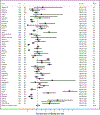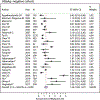Spontaneous loss of surface antigen among adults living with chronic hepatitis B virus infection: a systematic review and pooled meta-analyses
- PMID: 30679109
- PMCID: PMC6541384
- DOI: 10.1016/S2468-1253(18)30308-X
Spontaneous loss of surface antigen among adults living with chronic hepatitis B virus infection: a systematic review and pooled meta-analyses
Abstract
Background: Spontaneous loss of HBsAg (known as functional cure) in patients with chronic hepatitis B virus (HBV) infection significantly reduces liver-related complications. HBsAg loss has been suggested to be higher in non-endemic regions than in endemic regions in individual studies. We systematically determined a pooled annual rate of HBsAg loss in adults with untreated chronic HBV infection and examined the effect of regional endemicity.
Methods: In this systematic review and meta-analysis, we searched PubMed and Embase for observational cohort studies and non-treatment arms of randomised controlled trials reporting proportions of patients with chronic HBV infection that achieved spontaneous HBsAg loss, published up to Oct 1, 2018. We excluded randomised controlled trials from meta-analyses because of substantial cohort differences. Two reviewers (KZ and CC) independently extracted data from accepted full-text studies, with discrepancies discussed with a third reviewer (NT). We assessed rate of HBsAg loss, and stratified results by whether the underlying cohort arose primarily from an endemic region (defined as having prevalence of chronic HBV greater than 2%) or non-endemic region. This study is registered with PROSPERO, number CRD42018074086.
Findings: Of 5186 studies screened, 67 (11 randomised controlled trials, 39 prospective and 17 retrospective cohort studies) met the inclusion criteria and 56 were included in meta-analyses after exclusion of randomised controlled trials. Spontaneous HBsAg loss occurred in 3837 (7·8%) of 48 972 patients, with cumulative 352 381 person-years of follow-up. The pooled annual incidence of HBsAg loss was 1·17% (95% CI 0·94-1·41, I2=97%). Rates did not differ by endemicity: 1·19% (0·88-1·54) in endemic versus 1·29% (0·99-1·62) in non-endemic cohorts.
Interpretation: Globally, spontaneous HBsAg loss occurs infrequently (about 1% per year) in treatment-naive adults with chronic HBV infection. The low and homogeneous rate of HBsAg loss highlights the need for new therapeutics aimed at achieving functional cure across different patient groups and geographical regions.
Funding: NIH National Institute of Diabetes and Digestive and Kidney Diseases.
Copyright © 2019 Elsevier Ltd. All rights reserved.
Figures







Comment in
-
The widespread rarity of HBsAg loss in chronic hepatitis B.Lancet Gastroenterol Hepatol. 2019 Mar;4(3):190-192. doi: 10.1016/S2468-1253(18)30384-4. Epub 2019 Jan 22. Lancet Gastroenterol Hepatol. 2019. PMID: 30679108 No abstract available.
References
-
- Schweitzer A, Horn J, Mikolajczyk RT, Krause G, Ott JJ. Estimations of worldwide prevalence of chronic hepatitis B virus infection: a systematic review of data published between 1965 and 2013. Lancet. 2015;386(10003):1546–55. - PubMed
-
- Lemoine M, Eholie S, Lacombe K. Reducing the neglected burden of viral hepatitis in Africa: strategies for a global approach. J Hepatol. 2015;62(2):469–76. - PubMed
-
- Yuan T, Jiang Y, Li M, Li W. Chronic hepatitis B surface antigen seroclearance-related immune factors. Hepatol Res. 2017;47(1):49–59. - PubMed
-
- Chu CM, Liaw YF. Hepatitis B surface antigen seroclearance during chronic HBV infection. Antivir Ther. 2010;15(2):133–43. - PubMed
Publication types
MeSH terms
Substances
Grants and funding
LinkOut - more resources
Full Text Sources
Research Materials
Miscellaneous

